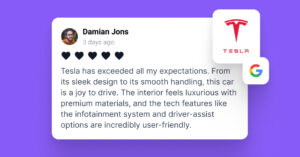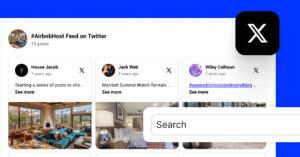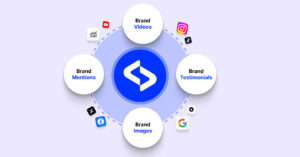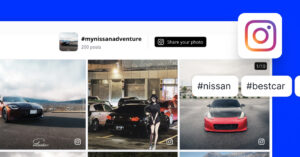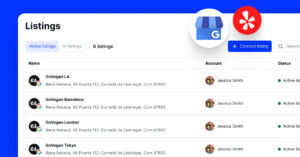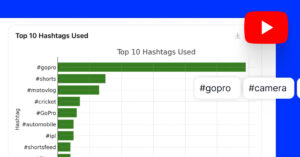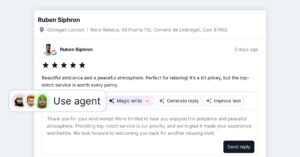Nous savons tous que les stories Instagram ont attiré l'attention de tous les spécialistes du marketing dans le monde et ont réussi à reprendre le format des stories à Snapchat et TikTok.
Selon la Dernières mises à jour d'InstagramLa plateforme évolue au-delà du format carré des photos et mise énormément sur les formats vidéo d'Instagram. Les utilisateurs d'iPhone iOs et d'Android peuvent utiliser des fonctions innovantes pour faire des boomerangs, des selfies mains libres, reposter ou simplement regarder les histoires de leurs influenceurs préférés.
Dans cette relation, nous avons des stats Instagram Stories intéressantes pour prouver pourquoi ce format de média social devrait être inclus dans votre stratégie marketing.
Vous trouverez ici des statistiques et des informations utiles, allant de données générales sur l'utilisation globale des stories Instagram à des études de cas réels qui témoignent de la performance des publicités pour les stories Instagram.
- Statistiques générales sur les Stories Instagram
- Comment afficher les analyses des Stories Instagram ?
- Quelles sont les métriques des stories Instagram à surveiller ?
- Comment analyser les données des Stories Instagram ?
- Comment agréger et stocker les données des Stories Instagram ?
- Analyse des publicités Instagram Story
- Bonus : les outils des Stories Instagram pour de meilleurs résultats
- Comment optimiser votre stratégie marketing à partir des analyses des Stories Instagram : Exemples pratiques
- FAQ sur l'analyse des stories Instagram
- Conclusion
POUR INFO: Vous pouvez intégrer le widget Instagram stories automatiquement sur votre site web et afficher vos stories Instagram en quelques secondes. Essayez-le maintenant.
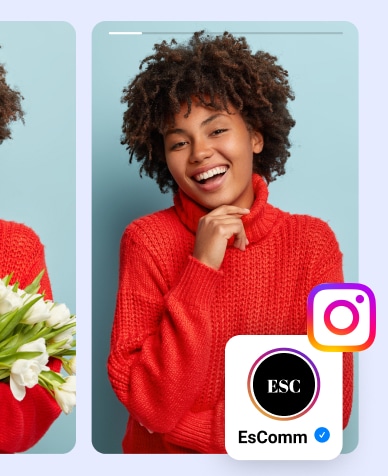
Affichez automatiquement les stories Instagram sur votre site web
Générer automatiquement et intégrer des histoires Instagram pour libérer le potentiel de vente de votre site web.
Statistiques générales sur les Stories Instagram
Il s'agit de statistiques officielles publiées par l'équipe d'Instagram concernant l'utilisation et l'adoption massive des stories Instagram non seulement par les utilisateurs réguliers, mais aussi par... Entreprises sur Instagram du monde entier.
Nous avons souligné ces 5 points de données pour comprendre le pouvoir des stories Instagram et pourquoi ce format gagne autant de terrain.
Voici donc les principales statistiques montrant combien de personnes utilisent les stories Instagram et quelle est la popularité de ce format :
- Les stories Instagram sont utilisées par 500 millions d'utilisateurs par jour (Données internes d'Instagram, janvier 2019)
- Un tiers (1/3) des Stories Instagram les plus vues sont celles d'entreprises
- 50% des entreprises sur Instagram dans le monde ont créé au moins une story au cours d'un mois type.
- 96% des marketeurs américains interrogés prévoient de continuer à utiliser les Stories ads dans les 6 prochains mois.
Et si l'on compare ce format au format actuel, le plus populaire, tel que Facebook et l'application Flux InstagramIl est donc possible de prédire que le partage par le biais des stories Instagram dépassera le partage par le biais des Feed views.

Énorme, n'est-ce pas ?
D'autres géants de la technologie suivent également la tendance avec le lancement récent de Histoires LinkedIn et Histoires de Google.
Voyons si ce chiffre élevé peut réellement avoir un impact sur votre utilisation des histoires et si vous pouvez obtenir certains des résultats que ce format promet.
Comment afficher les analyses des Stories Instagram ?
Dans la section précédente, nous avons vu que les stories Instagram sont généralement des formats durables. Mais pour le constater par nous-mêmes, nous devons commencer à surveiller les insights Instagram de nos propres stories.
Dans le texte suivant, nous expliquons les perspectives de l'histoire d'Instagram.
À l'instar de la section d'analyse de votre compte et de vos posts Instagram, l'analyse et l'aperçu de votre histoire se trouvent dans le coin supérieur droit de votre page d'accueil. Instagram business en cliquant sur le bouton "Insights".
Si vous n'avez toujours pas vu la section Insights dans votre compte Instagram, voici les étapes pour y accéder.
Remarque : avant de commencer à chercher la section Insights, assurez-vous que votre Le profil Instagram est converti en profil d'entreprise en connectant votre compte Instagram à votre page professionnelle Facebook officielle. Une fois cette opération effectuée, vous obtiendrez l'option Insights dans votre profil Instagram.
Il existe plusieurs façons de consulter les statistiques de vos articles, selon que vous souhaitez voir les informations relatives à l'article en cours/en direct ou que vous souhaitez consulter les données historiques relatives aux articles précédents.
Pour accéder aux stories Instagram de la story active, procédez comme suit :
- Tout d'abord, créez une histoire IG en cliquant sur l'icône de votre profil.
- Choisissez une photo existante dans le rouleau de l'appareil photo ou prenez une photo en tapant sur l'icône de l'appareil photo.
- Choisissez un emoji et publiez l'histoire en tapant en bas à droite.
- Après quelques minutes ou quelques heures, tapez à nouveau sur l'histoire en cours.
- Balayez vers le haut l'article que vous êtes en train de consulter
- Une vue du tiroir inférieur s'ouvrira avec les informations sur l'histoire.
- Appuyez sur l'icône (œil) pour afficher les utilisateurs d'Instagram qui ont consulté la story.
- Appuyez sur l'icône (graphique) pour afficher les informations relatives à l'article.
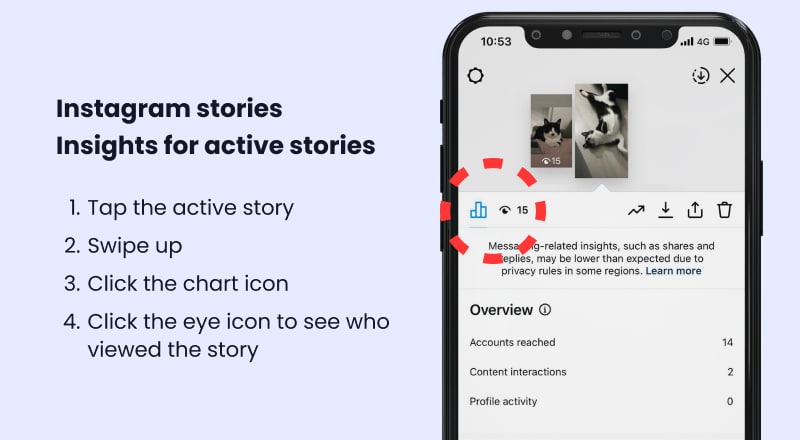
Si vous souhaitez accéder aux informations sur les Faits marquants sur InstagramLes étapes ci-dessus sont les mêmes. Il vous suffit d'aller sur votre profil et de taper sur un Highlight, puis d'effectuer un swipe vers le haut, et appuyez sur l'icône de graphique expliquée précédemment.
Pour afficher les analyses et les informations sur les stories Instagram pour toutes vos stories précédentes, suivez ces étapes :
- Accédez à votre profil
- Appuyez sur l'icône en haut à droite (menu)
- Appuyez sur l'élément de menu Insights
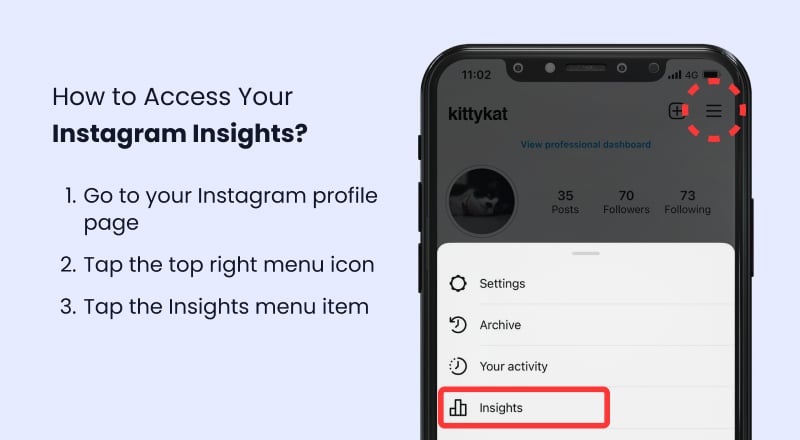
Ensuite, vous pouvez voir comment accéder aux données historiques de toutes vos histoires.
Il suffit de suivre les étapes suivantes :
- Dans l'écran Insights, tapez sur le menu Contenu.
- Faites défiler vers le bas jusqu'à la section Histoires
- Appuyez sur le lien Voir tout >.
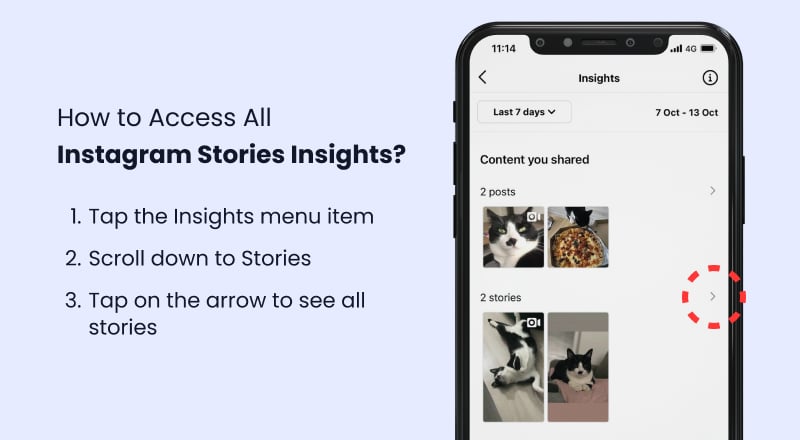
Dans cette section, vous pouvez consulter les informations relatives à chaque article. Vous remarquerez que dans la mise en page, les histoires sont organisées en fonction des diapositives et qu'une mesure est affichée en bas au milieu.
Chaque indicateur peut être modifié en cliquant sur le mot bleu de l'indicateur supérieur qui est sélectionné à ce moment-là. Voici comment procéder.
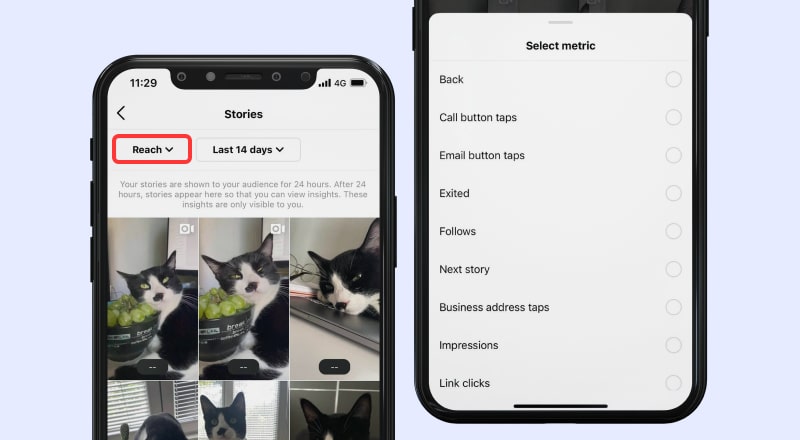
Quelles sont les métriques des stories Instagram à surveiller ?
Une fois que vous accédez à vos insights Instagram stories, vous verrez certains éléments de données spécifiques qui sont très uniques au format story. Afin de comprendre leur signification et la façon dont Instagram les mesure, veuillez consulter le site officiel de l'entreprise. Définition d'Instagram stories insights pour connaître les indicateurs les plus courants des stories Instagram :
- Impressions: Cette mesure correspond au nombre total de fois où les utilisateurs ont vu votre article. Le suivi des impressions vous permet de mesurer la portée de votre contenu et d'identifier les articles qui trouvent un écho auprès de votre public.
- Atteindre: Contrairement aux impressions, la portée ne comptabilise que les utilisateurs uniques qui ont consulté votre article. Cette mesure vous aide à comprendre l'efficacité avec laquelle votre contenu élargit votre audience et vous permet de comparer les performances de différents articles.
- Taux d'engagement : Pour mesurer le niveau d'interaction de vos histoires, regardez le taux d'engagement. Cette mesure prend en compte les actions telles que les réponses, les appuis sur les autocollants et les swipe-ups et correspond au nombre total d'engagements divisé par le nombre d'affichages uniques. Un taux d'engagement élevé indique que votre contenu suscite des interactions et attire l'attention de votre public.
- Sorties: Gardez un œil sur le nombre d'utilisateurs qui quittent votre histoire avant la fin. Un taux de sortie élevé peut indiquer que votre contenu ne trouve pas d'écho auprès des internautes, ce qui les incite à le quitter avant la fin. Utilisez cette mesure pour identifier les tendances et adapter votre stratégie de contenu en conséquence.
- Tape en avant : Cette mesure indique le nombre de fois où les utilisateurs appuient sur le bouton pour passer à l'article suivant. Un nombre élevé de clics vers l'avant peut indiquer que votre contenu n'est pas assez intéressant ou qu'il est trop long. Expérimentez différents formats et longueurs pour trouver ce qui convient le mieux à votre public.
- Taps Backward : À l'inverse, le nombre d'appuis en arrière correspond au nombre de fois où les utilisateurs appuient sur la touche pour revoir l'article précédent. Cela peut être un indicateur positif, car cela montre que votre contenu était suffisamment intéressant pour que les utilisateurs veuillent le revoir.
- Taux d'achèvement : Cet indicateur mesure le pourcentage d'utilisateurs qui regardent votre histoire du début à la fin. Un taux d'achèvement élevé indique que votre contenu est attrayant et qu'il retient l'attention de l'internaute pendant toute la durée de l'histoire.
- Interactions d'autocollants : Les Stories Instagram proposent une variété d'autocollants interactifs tels que des sondages, des questions et des quiz. Surveillez l'engagement et le taux de réponse de chaque type d'autocollant pour comprendre quels éléments interactifs fonctionnent le mieux pour votre contenu.
Dans la prévisualisation de l'aperçu de l'histoire, vous verrez également une section avec des Interactions qui pourraient inclure les points de données suivants : Réponses, Clics sur le site web, et Visites de profil.
Il convient également de mentionner le Autocollantsqui indique le nombre de fois où les internautes ont appuyé sur un hashtag, une balise de lieu, une mention ou un autocollant de produit dans votre Story.
Il est bon de savoir qu'Instagram affiche ces données à partir du moment où vous avez converti votre compte personnel en compte professionnel. Ainsi, pour toutes les stories précédentes, vous ne pourrez pas consulter les analyses des stories Instagram.
Comment mesurer les métriques de découverte dans l'analyse des Stories Instagram ?
Les métriques de découverte dans Instagram Stories Analytics donnent des indications sur la façon dont votre contenu est découvert et visionné par votre public. Pour accéder à ces métriques, suivez les étapes suivantes :
- Ouvrez votre profil Instagram et appuyez sur le menu hamburger dans le coin supérieur droit.
- Sélectionner "Perspectives"dans le menu.
- Naviguez jusqu'à la page "Contenu que vous avez partagé"et choisissez "Histoires.”
- Ouvrez un article que vous souhaitez analyser et consultez les sections Vue d'ensemble, Engagement et Portée pour afficher des mesures telles que les Impressions, la Portée et les Suivis.
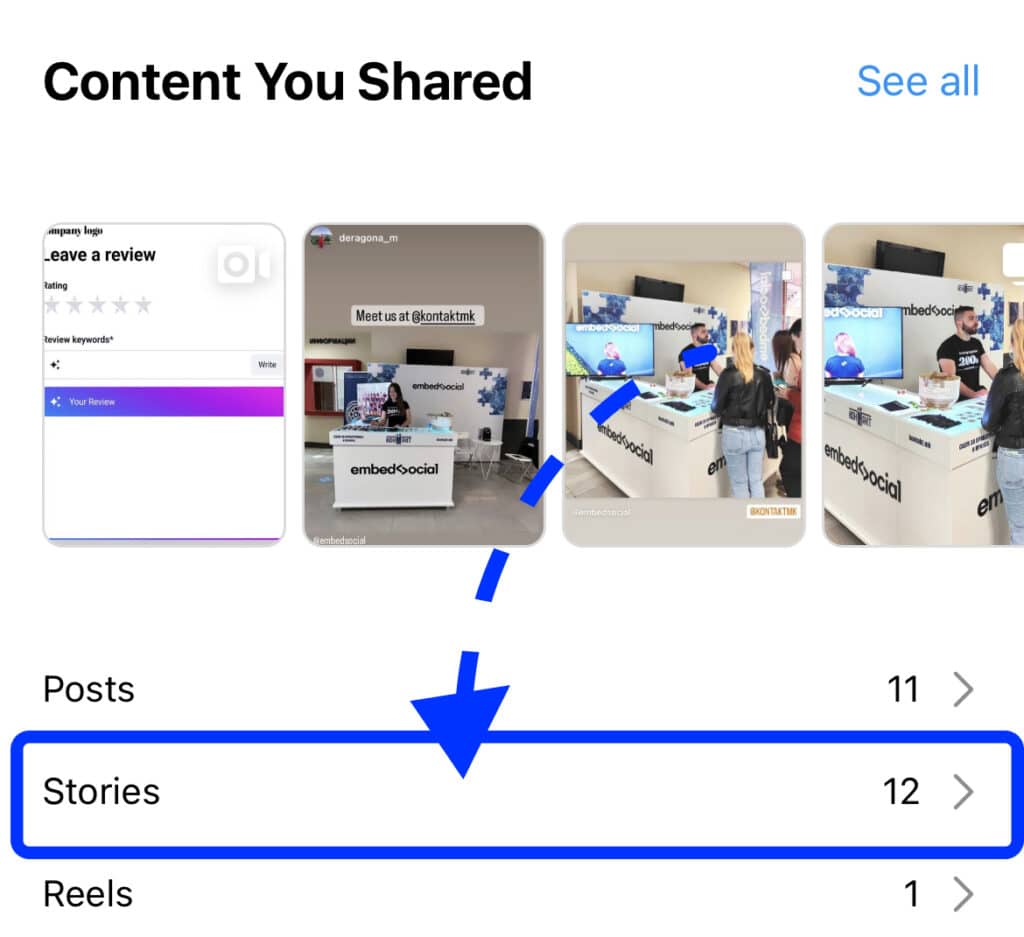
En analysant les mesures de découverte, vous pouvez évaluer la visibilité et l'efficacité de votre contenu pour atteindre de nouveaux publics.
Comment mesurer les métriques de navigation dans Instagram Stories Analytics ?
Les mesures de navigation vous aident à comprendre comment votre public interagit avec vos histoires, notamment en les sautant, en les rembobinant ou en les quittant. Pour mesurer ces paramètres, suivez les étapes ci-dessous :
- Accédez aux Insights de votre profil Instagram en suivant les étapes ci-dessus.
- Naviguez jusqu'à la page "Contenu que vous avez partagé"et sélectionnez "Histoires.”
- Faites défiler vers le bas jusqu'à la rubrique "NavigationLa section " Taps Forward, Taps Backward et Exits " permet d'afficher des indicateurs tels que le nombre d'écoutes en avant, le nombre d'écoutes en arrière et le nombre d'abandons.
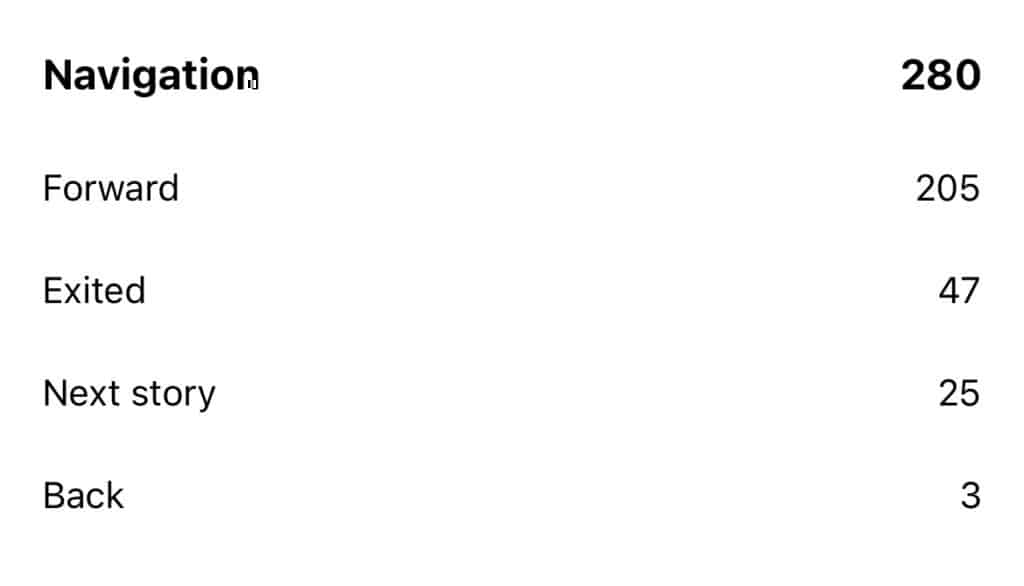
Utilisez ces données pour identifier les modèles de comportement du public et optimiser votre contenu pour améliorer l'engagement et la fidélisation.
Comment mesurer la performance des autocollants de hashtag et de lieu sur les Stories Instagram ?
Pour mesurer la performance des autocollants de hashtag et de lieu dans vos Stories Instagram, suivez ces étapes :
- Accédez aux Insights de votre profil Instagram en suivant les étapes ci-dessus.
- Naviguez jusqu'à la page "Contenu que vous avez partagé" et sélectionnez "Histoires".
- Choisissez une histoire individuelle qui comprend un hashtag ou un autocollant de lieu.
- Voir le "Sticker Taps" pour voir combien d'utilisateurs ont interagi avec l'autocollant.
Suivez les performances des différents autocollants pour identifier ceux qui suscitent le plus d'engagement et utilisez-les de manière stratégique dans vos futurs articles.
Comment mesurer les métriques d'interaction dans Instagram Stories Analytics ?
Les mesures d'interaction donnent un aperçu de la façon dont votre public interagit avec vos histoires, y compris les réponses, les appuis sur les autocollants et les swipe-ups. Pour mesurer ces paramètres, suivez les étapes ci-dessous :
- Accédez aux Insights de votre profil Instagram en suivant les étapes ci-dessus.
- Accédez à l'onglet "Contenu" et sélectionnez "Histoires".
- Faites défiler vers le bas jusqu'à la section "Interactions" pour afficher des mesures telles que les réponses, les clics sur l'autocollant et les swipe-ups.
Utilisez ces informations pour comprendre quels types de contenu et d'éléments interactifs encouragent davantage l'engagement du public et intégrez-les dans votre stratégie Instagram Stories.
Nouvelles mesures pour les Stories Instagram
Instagram déploie constamment de nouvelles fonctionnalités et des indicateurs connexes.
Certaines des métriques les plus récentes dans l'analyse des stories Instagram sont : Directions, Appels, Textes et Emails - qui sont liés à l'effet que les stories Instagram ont eu sur l'action réalisée sur les boutons CTA de votre profil.
Comment analyser les données des Stories Instagram ?
Dans le texte suivant, nous vous montrerons quelques astuces pour analyser les métriques de vos stories Instagram et répondrons à quelques questions courantes que vous pourriez vous poser sur les données des stories que vous verrez dans votre compte.
Quelle est la différence entre la portée et les impressions dans l'analyse des Stories Instagram ?
La différence vient du fait qu'une même personne peut voir votre article plusieurs fois. Ainsi, si elle consulte votre article 5 fois, vous obtiendrez 5 impressions supplémentaires.
Quant à la mesure de la portée, elle représente le nombre de personnes uniques qui ont vu l'article et le nombre de fois qu'elles l'ont vu.
Qu'est-ce qui est le mieux, les robinets en arrière ou les robinets en avant ?
En bref, des robinets à l'envers. Pourquoi ? Si les gens tapent davantage vers l'arrière, cela peut signifier qu'ils ont vu une plus grande partie de votre histoire, ce qui est intéressant, et qu'ils y retournent donc pour y passer plus de temps.
Le fait d'aller vers l'avant peut indiquer que certaines parties de la diapositive sont peut-être ennuyeuses ou ne donnent pas assez d'informations, de sorte que les gens veulent aller directement à la fin pour comprendre l'idée de l'histoire.
Mais notez que sur les diapositives comportant des flèches ou un appel explicite à l'action pour naviguer plus loin, le nombre de clics vers l'avant peut être de plus en plus élevé par rapport à d'autres diapositives. Il s'agit donc d'un résultat attendu de l'action que vous souhaitez que la diapositive sur l'histoire permette de réaliser.
Comment les sorties sont-elles calculées ?
Par définition, il y a sortie lorsqu'une personne quitte votre histoire. Cela ne signifie pas qu'elle est revenue en arrière ou qu'elle a tapé en avant. Cela signifie qu'elle :
- Appuyez sur l'icône x
- Passage à l'article suivant d'un autre compte
- Fermer l'application Instagram
- Il s'est rendu sur leur fil d'actualité.
La conclusion est donc que l'objectif principal de l'histoire est de réduire le pourcentage de sorties par rapport à la portée.
Comment mesurer les clics et les CTR sur mon site web ?
Pour mesurer le taux de clics ou le nombre de clics des articles vers votre site web, vous pouvez inclure un lien de type UTM dans votre bouton "En savoir plus".
Afin de suivre Instagram stories et mesurer plus précisément la performance des stories Instagram, vous pouvez suivre le nombre de clics arrivant sur votre site web dans Google Analytics.
Dans de nombreux cas, ce bouton Voir plus n'est toujours pas disponible. Si vous n'avez pas cette option, vous pouvez essayer d'ajouter la mention @ pour mener directement à votre profil, où vous pouvez ajouter le lien UTM dans la section bio.
POUR INFO: Vous pouvez intégrer le widget Instagram stories automatiquement sur votre site web et afficher vos stories Instagram en quelques secondes. Essayez-le maintenant.
Comment agréger et stocker les données des Stories Instagram ?
Si vous avez déjà eu l'occasion d'analyser le succès de vos stories Instagram organiques, vous conclurez que l'actuelle section Insights décrite ci-dessus est créée pour les petits utilisateurs ou les comptes professionnels qui n'ont probablement pas besoin d'analyser de manière programmatique le succès de leurs stories.
Mais, si vous souhaitez une approche professionnelle dans l'analyse des insights des stories Instagram, vous aurez besoin d'un outil ou d'un logiciel tiers pour vous aider à en faire plus avec les données de vos stories.
Le Visionneuse d'histoires Instagram plate-forme, EmbedStories s'attaque à ce problème et le résout grâce à une série de fonctionnalités qui peuvent aider à analyser les données des histoires à une plus grande échelle.
Voici quelques fonctionnalités offertes par EmbedStories :
- Générer automatiquement des histoires et leurs points de données Instagram
- Collecter et stocker ces données en un seul endroit avec des fonctions facilement accessibles
- Options pour intégrer les histoires sur n'importe quel site web
- Des points de données uniques pour le succès de vos histoires sur votre site web
- Booster les Stories Instagram en publicités
Voici un exemple de widget Instagram stories intégré dans cet article de blog, à l'aide de la plateforme EmbedStories :
Voici une capture d'écran en mode comparaison pour avoir un aperçu des histoires générées dans le système EmbedStories :
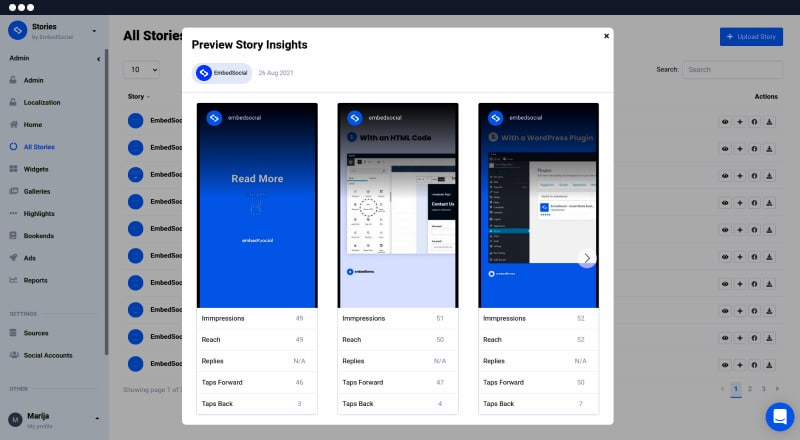
En ce qui concerne l'analyse Instagram des histoires intégrées sur votre site web, voici un exemple de rapport sur les performances d'une histoire au-delà d'Instagram :
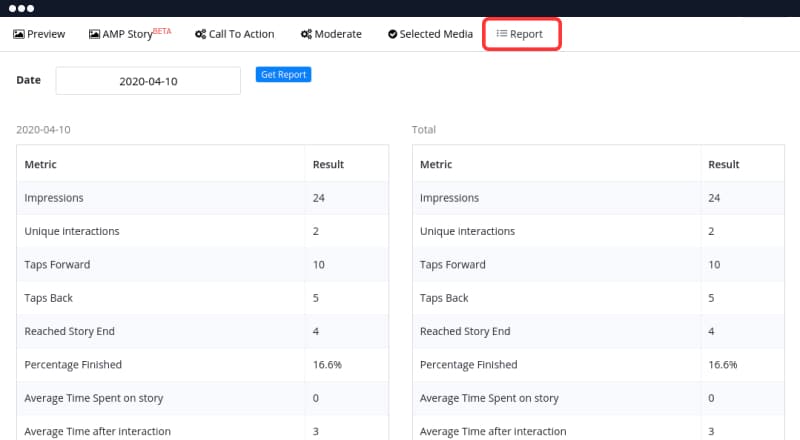
Pour plus de détails sur l'analyse des Insta Stories dans EmbedStories, consultez la page tutoriels d'analyse.
Analyse des publicités Instagram Story
Lorsqu'il s'agit d'utiliser le format Stories pour créer et stimuler les publicités sponsorisées, les résultats obtenus par la plupart des entreprises sont plutôt impressionnants.
Ce format vertical et mobile semble répondre davantage au comportement de l'utilisateur, de sorte qu'il est tout à fait logique de disposer d'une publicité native capable d'engager le dialogue avec l'utilisateur en plein écran pour obtenir d'excellents résultats.
Nous avons analysé quelques exemples de réussite qu'Instagram publie sur sa page professionnelle officielle, et sur la base de cette enquête, nous sommes parvenus aux statistiques communes suivantes auxquelles on peut s'attendre si l'on diffuse des publicités Instagram stories :
- Plus d'achats avec des publicités dans les Stories que dans les flux
- Coût par acquisition plus faible avec les publicités dans les Stories qu'avec les flux.
- Plus de % d'achats de prospection attribuables aux publicités dans les Stories Instagram.
- Augmentation de la mémorisation de la publicité et de la notoriété globale
En outre, une mesure importante que les spécialistes du marketing définissent généralement pour leurs objectifs de marketing Instagram est d'augmenter les clics sur le site web le... Clics sur les liens métrique.
Cela vient de la pratique courante qui consiste à créer des publicités pour les stories Instagram afin d'obtenir l'option CTA qui permet d'ajouter un lien personnalisé dans la story. Il s'agit du principal cas d'utilisation pour les comptes Instagram qui n'ont toujours pas la possibilité d'ajouter des liens à leurs stories organiques.
Voici d'autres indicateurs des publicités Instagram Story que vous devrez surveiller :
- Résultats : Clics sur les liens
- Coût par résultat
- Résultat Taux
- Résultat Taux
- Clics uniques sur les liens
- Pages d'atterrissage consultées
- Note de pertinence
Pour accéder aux insights des publicités Instagram story, vous devez vous rendre sur votre compte Facebook Ads Manager et afficher les données graphiques de la publicité Instagram story. Le rapport principal que vous devrez surveiller ressemble à l'exemple ci-dessous :
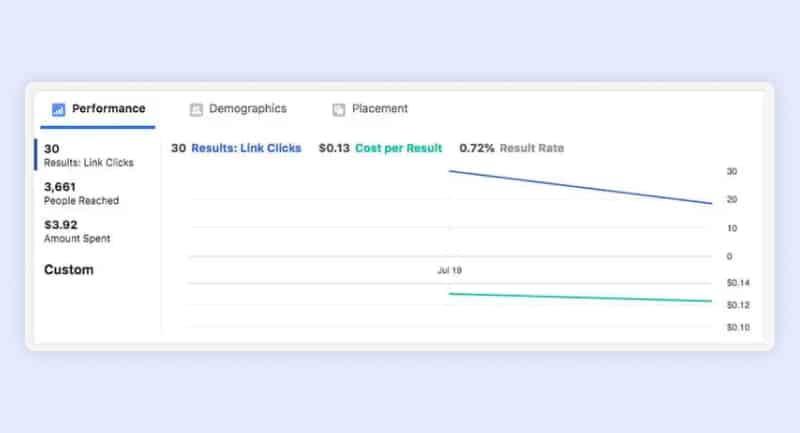
Bonus : les outils des Stories Instagram pour de meilleurs résultats
Comme nous le savons tous, Instagram Stories est un excellent moyen de partager les petits moments de la vie avec vos followers. Et maintenant, vous n'avez plus besoin d'investir des milliers de dollars dans des entreprises de conception ou des logiciels juste à cette fin - il y a beaucoup de... outils gratuits disponibles pour votre contenu Instagram afin de vous apporter un certain nombre de vues et d'engagement.
Voici une liste des outils à envisager pour améliorer les performances des stories Insta :
1. Histoires IG maker – Canva est un outil populaire lorsqu'il s'agit de créer du contenu de haute qualité sur les médias sociaux, en particulier des posts et des stories Instagram. Il existe de nombreux modèles que vous pouvez utiliser, et avec leur éditeur facile à glisser-déposer, vous pouvez aller au-delà de la créativité. Vous pouvez ajouter des autocollants, des images et tout ce qui peut étonner les utilisateurs d'Instagram.
2. Animateur de stories Instagram - Vous pouvez utiliser Boomerang pour créer des vidéos Instagram inattendues pour vos stories. Instagram lui-même dispose de cette animation, mais cet outil vous propose de créer des vidéos de manière plus créative et non seulement pour vos Insta stories et Instagram Reels, mais aussi pour des stories sur d'autres plateformes comme Snapchat, TikTok, ou même WhatsApp.
3. Planificateur d'histoires Instagram - Eh bien, vous n'aurez pas toujours le temps de publier manuellement des articles sur votre page de profil. Tampon est un outil formidable qui vous aide à programmer vos stories à l'avance et à les publier ponctuellement sur votre profil Instagram. C'est un outil très populaire entre les influenceurs, les entreprises et les créateurs.
4. Générateur d'histoires Insta – EmbedStories est l'outil idéal si vous souhaitez étendre la portée de vos stories au-delà d'Instagram. Il vous permet de créer un widget de vos stories Insta et de les afficher sur votre site web. Il s'intègre à l'application Algorithme d'InstagramVous pouvez ainsi intégrer votre compte Instagram à votre site web. De plus, vous pouvez également imiter les moments forts des stories. Désormais, vos abonnés peuvent regarder des stories Instagram sur votre site web !
5. Générateur de hashtag Insta - Qu'est-ce qu'une application Instagram sans hashtags ? Hashtag For Likes est l'outil qui vous aidera à agrandir votre liste de spectateurs sur Instagram. En fonction de votre objectif marketing sur Instagram, ce générateur vous proposera des hashtags faciles, moyens et difficiles dans l'ordre chronologique. C'est à vous de choisir ceux que vous souhaitez utiliser.
6. Visionneuse d'histoires Instagram - Les stories disparaissent au bout de 24 heures, mais vous pouvez toujours les archiver pour que vos followers puissent encore les consulter ultérieurement. Vous pouvez utiliser les options natives d'Instagram pour archiver et télécharger Instagram storiesmais vous pouvez améliorer votre niveau et sauvegarder les meilleures histoires dans une application en ligne comme EmbedStories.
Comment optimiser votre stratégie marketing à partir des analyses des Stories Instagram : Exemples pratiques
L'exploitation des analyses des Stories Instagram peut améliorer considérablement votre stratégie marketing et stimuler l'engagement du public. Voici quelques exemples pratiques pour optimiser votre approche en fonction des informations recueillies :
Identifier le contenu le plus performant
Si votre contenu en coulisses reçoit régulièrement des impressions et des taux d'engagement plus élevés, créez davantage de contenu de ce type pour établir un lien personnel avec votre public.
Optimiser le format et la longueur de l'article
Si vous remarquez que les taux de sortie sont plus élevés pour les articles longs ou ceux qui ont un format spécifique, essayez de diviser le contenu en segments plus courts et plus digestes ou expérimentez des formats différents, tels que des clips vidéo ou des images avec du texte superposé.
Expérimenter des éléments interactifs
Si votre public s'intéresse davantage aux sondages qu'aux quiz, utilisez davantage de sondages dans vos articles pour encourager l'interaction.
Par exemple, demandez à votre public de voter pour leurs caractéristiques de produit ou leurs options de couleur préférées.
Analyser les performances des hashtags et des autocollants de localisation
Si vos histoires avec des hashtags spécifiques ou des autocollants de lieu reçoivent plus d'appuis d'autocollants, utilisez-les stratégiquement pour augmenter la visibilité.
Par exemple, inclure des hashtags populaires liés au secteur ou indiquer l'emplacement de votre magasin pour attirer des adeptes locaux.
Publier à des heures optimales
Si vos analyses montrent des taux d'engagement plus élevés en semaine à 19 heures, programmez la mise en ligne de vos articles à ce moment-là pour maximiser la visibilité et l'interaction avec le public.
Suivre l'évolution démographique de l'audience
Si votre public principal est composé de femmes âgées de 25 à 34 ans, créez du contenu qui répond à leurs intérêts et à leurs besoins.
Par exemple, si vous êtes une marque de mode, mettez en avant les styles à la mode et proposez des inspirations de tenues adaptées à ce groupe démographique.
Exploiter le contenu généré par les utilisateurs
Repostez des contenus de clients satisfaits présentant votre produit en utilisation, comme un client portant votre marque de vêtements lors d'une soirée, ou un utilisateur montrant les résultats de vos produits de soin de la peau. Cela peut contribuer à renforcer la confiance et la crédibilité de votre public.
Suivez et mesurez vos objectifs
Si votre objectif est d'augmenter le trafic sur votre site web, surveillez le nombre de swipe-ups sur les stories présentant des promotions de produits ou des teasers d'articles de blog. Si les résultats sont inférieurs à votre objectif, ajustez votre stratégie en affinant vos appels à l'action ou en proposant un contenu exclusif aux adeptes d'Instagram.
En mettant en œuvre ces conseils pratiques avec des exemples concrets et en examinant régulièrement vos Instagram Stories Analytics, vous pouvez continuellement affiner votre stratégie marketing, créer des contenus plus percutants et favoriser des connexions plus fortes avec votre public.
FAQ sur l'analyse des stories Instagram
Snapchat a été la première plateforme de médias sociaux à mettre en œuvre cette fonctionnalité. Mais que vous ayez déjà utilisé cette application ou non, les stories Instagram sont très faciles à consulter.
Les histoires IG utilisent la même interface sur iOs et Android, peu importe que vous utilisiez un iPhone ou un autre smartphone.
Il vous suffit d'ouvrir votre application Instagram et, en haut de l'écran, vous verrez une série de mini photos de profil entourées de cercles. Il s'agit en fait des histoires. Appuyez sur la première (ou sur celle que vous voulez voir), et c'est tout.
Si vous souhaitez afficher toutes les photos et vidéos d'une même histoire, il vous suffit de toucher l'écran pour qu'elles changent.
Et si vous voulez passer d'une histoire à une autre, il vous suffit de glisser vers la droite pour voir l'histoire de l'utilisateur suivant.
Remarque : Si vous n'effectuez aucune action sur l'écran pendant que vous regardez des histoires, elles passeront automatiquement d'une photo/vidéo à l'autre au sein de la même histoire. Et juste après, l'histoire de l'utilisateur suivant s'ouvrira. Vous pouvez donc regarder des histoires en gardant les mains libres. Sympa, non ?
Puisque les Insta Stories deviennent aussi populaires que les posts Instagram, en tant qu'entreprise, vous devriez envisager de les inclure dans votre... marketing des médias sociaux stratégie.
Les IG stories sont une fonctionnalité intéressante qui permet aux utilisateurs d'Instagram de partager une histoire temporaire avec leurs followers, dans un format très immersif.
Pour créer une IG Story, appuyez sur votre photo de profil dans le coin supérieur gauche en haut de votre écran. Vous pouvez prendre des photos et des vidéos directement depuis l'application (en appuyant sur l'icône de l'appareil photo) ou les télécharger depuis votre rouleau d'appareils photo.
Une fois que vous avez choisi votre histoire, vous pouvez l'adapter comme bon vous semble. Par exemple, vous pouvez prendre une vidéo boomerang, insérer un selfie en tant qu'image superposée, l'afficher en plein écran ou redimensionner la création. Il vous suffit de balayer l'écran vers la gauche pour afficher d'autres options de mise en page.
Pour rendre l'histoire plus attrayante, vous pouvez ajouter de nombreuses décorations et fonctionnalités à votre histoire, comme des autocollants, des gifs (giphy), des hashtags, des emojis, utiliser différentes polices, des autocollants de questions, des autocollants de hashtags, des autocollants de sondages, ajouter des liens, et vous pouvez également taguer des personnes.
Il existe également une autre fonctionnalité intéressante appelée Faits marquants des Stories Instagram qui vous permet de conserver vos histoires préférées sur votre compte pendant plus de 24 heures. Les faits marquants sont affichés en permanence sur votre profil et peuvent être mis à jour à tout moment.
Voyons maintenant à quoi ressemble une Story Instagram et quels sont ses éléments.
Tout d'abord, le corps de l'histoire est l'image ou la vidéo qui représente le contenu éphémère.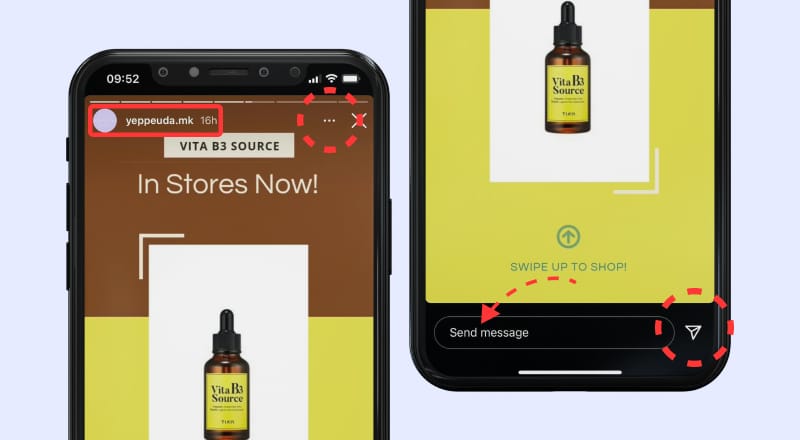
Dans le coin supérieur gauche se trouvent toujours la photo de profil et le nom d'utilisateur du propriétaire de la Story. Auparavant, s'il s'agissait d'un compte vérifié (comme un compte d'entreprise ou un influenceur célèbre), une icône de vérification se trouvait à côté du nom d'utilisateur, mais ce n'est plus le cas. Toutes les histoires de cette partie se ressemblent donc.
Dans le coin supérieur droit, trois points jaunes vous permettent de signaler l'histoire, de copier le lien de l'histoire, de la partager ou de mettre en sourdine les histoires de cet utilisateur.
En bas à gauche, il y a une barre de réponse sur laquelle vous pouvez appuyer pour envoyer un message direct à partir de l'histoire. Juste à côté se trouve une flèche de partage.
Si vous souhaitez partager l'histoire dans un message privé avec un autre utilisateur, appuyez sur la flèche, choisissez l'utilisateur Instagram auquel vous souhaitez envoyer l'histoire et cliquez sur "Envoyer".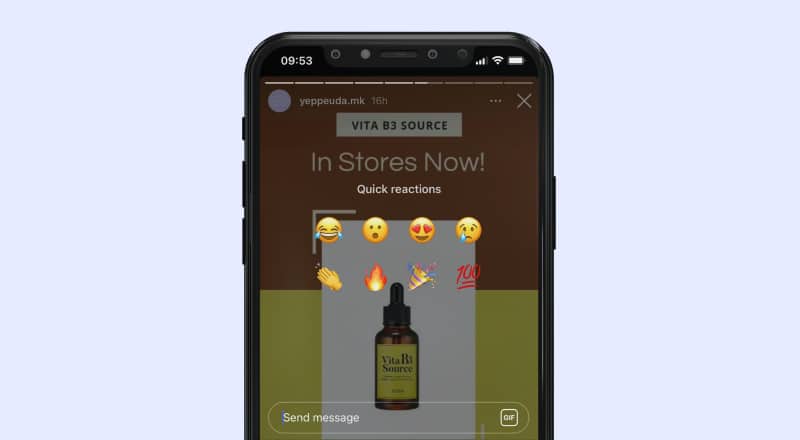
Une option vraiment sympa est celle des réactions aux histoires. Si vous balayez le bas de l'écran vers le haut, quelques emojis apparaîtront. Vous pouvez en choisir un et taper dessus pour faire savoir au propriétaire de l'histoire ce que vous pensez de son histoire sans avoir à taper quoi que ce soit.
Dernièrement, Instagram a mis en place une nouvelle fonctionnalité appelée Autocollant de lien qui est disponible dans la bibliothèque d'autocollants des stories et qui est la nouvelle solution pour ajouter des liens sur la story Instagram.
Conclusion
Les stories Instagram sont le format le plus natif qui a prouvé qu'il donnait d'excellents résultats pour les spécialistes du marketing numérique, et de nombreuses entreprises les intègrent déjà comme un élément essentiel de leur stratégie de contenu.
En comprenant les Algorithme d'Instagram et avec le bon contenu et l'amélioration constante des conceptions visuelles en utilisant des gifs, des vidéos ou divers modèles de stories, vous pouvez obtenir d'excellents résultats. Nous avons vu qu'il y a beaucoup d'analyses uniques des Stories Instagram, qui doivent être surveillées et analysées afin d'améliorer chaque future campagne qui inclura à la fois des stories Instagram organiques ou sponsorisées.
POUR INFO: Vous pouvez intégrer le widget Instagram stories automatiquement sur votre site web et afficher vos stories Instagram en quelques secondes. Essayez-le maintenant.

